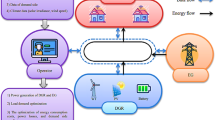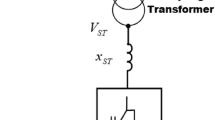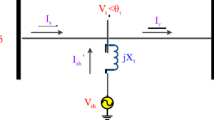Abstract
The paper proposes a new power flow model and calculation procedure for large-scale multi-phase (unbalanced) distribution networks with simultaneous phase interruptions. Differently from traditional linear models for calculations of networks with simultaneous short-circuits and phase interruptions, phase interruptions are treated in this paper much more realistically—as outages which are incorporated in a nonlinear phase-domain distribution power flow model. Using the compensation method, this model is decoupled per phases. The calculation of the energized part of the network is carried out using a backward–forward sweep (BFS)-based procedure. The calculation of the state of the deenergized part of the network, which appeared due to phase interruptions, is based on the linear loop current method. Thus, the efficiency of BFS is retained in the proposed procedure. The robustness and efficiency of the proposed procedure are demonstrated by calculating both a small test network and a real-life large-scale network.






Similar content being viewed by others
Notes
A (three-phase) bus consists of three (single-phase) nodes.
References
Strezoski VC, Bekut D (1991) A canonical model for the study of faults in power systems. IEEE Trans Power Syst 4:1493–1499. https://doi.org/10.1109/59.116995
Strezoski LV, Prica MD, Loparo KA (2017) Generalized Δ-circuit concept for integration of distributed generators in online short-circuit calculations. IEEE Trans Power Syst 4:3237–3245. https://doi.org/10.1109/TPWRS.2016.2617158
Shirmohammadi D, Hong HW, Semlyen A, Luo GX (1988) A compensation-based power flow method for weakly meshed distribution and transmission networks. IEEE Trans Power Syst 2:753–762. https://doi.org/10.1109/59.192932
Luo GX, Semlyen A (1990) Efficient load flow for large weekly meshed networks. IEEE Trans Power Syst 4:1309–1316. https://doi.org/10.1109/59.99382
Rajicic D, Taleski R (1998) Two novel methods for radial and weakly meshed network analysis. Electr Power Syst Res 2:79–87. https://doi.org/10.1016/S0378-7796(98)00067-4
Dilek M, de Leon F, Broadwater R, Lee S (2010) A robust multiphase power flow for general distribution networks. IEEE Trans Power Syst 2:760–768. https://doi.org/10.1109/TPWRS.2009.2036791
Wang Z, Chen F, Jingui L (2004) Implementing transformer nodal admittance matrices into backward/forward sweep-based power flow analysis for unbalanced radial distribution systems. IEEE Trans Power Syst 4:1831–1836. https://doi.org/10.1109/TPWRS.2004.835659
Mashhour E, Moghaddas-Tafreshi SM (2009) Three-phase backward/forward power flow solution considering three-phase distribution transformers. IEEE Int Conf Ind Technol. https://doi.org/10.1109/ICIT.2009.4939610
Abdel-Acker M, Mahmoud K (2013) Unbalanced distribution power-flow model and analysis of wind turbine generating systems. Int Trans Electr Energy Syst 5:689–700. https://doi.org/10.1002/etep.1634
Strezoski VC, Vidović PM (2015) Power flow for general mixed distribution networks. Int Trans Electr Energy Syst 10:2455–2471. https://doi.org/10.1002/etep.1974
Arboleya P, Gonzalez-Moran C, Coto M (2013) Unbalanced power flow in distribution systems with embedded transformers using the complex theory αβ0 stationary reference frame. IEEE Trans Power Syst 3:1–11. https://doi.org/10.1109/TPWRS.2013.2292112
Džafić I, Neisius HT, Gilles M, Henselmeyer S, Landerberger V (2013) Three-phase power flow in distribution networks using fortescue transformation. IEEE Trans Power Syst 2:1027–1034. https://doi.org/10.1109/TPWRS.2012.2213278
Xiao P, Yu DC, Yan W (2006) A unified three-phase transformer model for distribution load flow calculations. IEEE Trans Power Syst 1:153–159. https://doi.org/10.1109/TPWRS.2005.857847
Cheng CS, Shirmohammadi D (1995) A three-phase power flow method for real-time distribution system analysis. IEEE Trans Power Syst 2:671–679. https://doi.org/10.1109/59.387902
Desoer C, Kuh E (1969) Basic circuit theory. McGraw-Hill, New York
Garcia PAN, Pereira JLR, Carneiro S, da Costa JVM, Martins N (2000) Three-phase power flow calculations using the current injection method. IEEE Trans Power Syst 2:508–514. https://doi.org/10.1109/59.867133
Vieira JCM Jr, Freitas W, Morelato A (2004) Phase-decoupled method for three-phase power-flow analysis of unbalanced distribution systems. IEE Proc Gener Transm Distrib 5:568–574. https://doi.org/10.1049/ip-gtd:20040831
Chen TH, Chen MS, Hwang KJ, Kotas P, Chebli EA (1991) Distribution system power flow analysis—a rigid approach. IEEE Trans Power Deliv 3:1146–1152. https://doi.org/10.1109/61.85860
Benato R, Paolucci A, Turri R (2001) Power flow solution by a complex admittance matrix method. Int Trans Electr Energy Syst 3:181–188. https://doi.org/10.1002/etep.4450110305
Tinney WF, Hart CE (1967) Power flow solution by Newton’s method. IEEE Trans Power Appar Syst 11:1449–1460. https://doi.org/10.1109/TPAS.1967.291823
Strezoski VC, Vojnović NR, Vidović PM (2018) New bus classification and unbalanced power flow of large-scale networks with electronically interfaced energy resources. Int Trans Electr Energy Syst 3:1–16. https://doi.org/10.1002/etep.2502
Zimmerman RD, Chiang HD (1995) Fast decoupled power flow for unbalanced radial distribution systems. IEEE Trans Power Syst 4:2045–2052. https://doi.org/10.1109/59.476074
Lin WM, Su YS, Chin HC, Teng JH (1999) Three-phase unbalanced distribution power flow solutions with minimum data preparation. IEEE Trans Power Syst 3:1178–1183. https://doi.org/10.1109/59.780956
Lin WM, Teng JH (2000) Three-phase distribution network fast-decoupled power flow solution. Int J Electr Power Energy Syst 5:375–380. https://doi.org/10.1016/S0142-0615(00)00002-8
Smolleck HA, Shoults RR (1990) A straightforward method for incorporating mutually-coupled circuits into the bus admittance matrix using the concept of artificial branches. IEEE Trans Power Syst 2:486–491. https://doi.org/10.1109/59.54557
Teng JH (2003) A direct approach for distribution system load flow solutions. IEEE Trans Power Deliv 3:882–887. https://doi.org/10.1109/TPWRD.2003.813818
Tinney WF, Walker JW (1967) Direct solutions of sparse network equations by optimally ordered triangular factorization. Proceeding IEEE 55(11):1801–1809. https://doi.org/10.1109/PROC.1967.6011
Obrenić MZ, Vidović PM, Strezoski LV (2019) A novel intervals-based algorithm for the distribution short-circuit calculation. Electr Eng 101:1145–1162. https://doi.org/10.1007/s00202-019-00853-2
Khushalani S, Solanki JM, Schulz NN (2007) Development of three-phase unbalanced power flow using PV and PQ models for distributed generation and study of the impact of DG models. IEEE Trans Power Syst 3:1019–1025. https://doi.org/10.1109/TPWRS.2007.901476
Chatzarakis GE, Tortoreli MD, Tziolas AD (2003) Fundamental loop-current method using ‘virtual voltage sources’ technique for special cases. Int J Electr Eng Educ 3:188–207. https://doi.org/10.7227/IJEEE.40.3.3
Author information
Authors and Affiliations
Corresponding author
Additional information
Publisher's Note
Springer Nature remains neutral with regard to jurisdictional claims in published maps and institutional affiliations.
Rights and permissions
About this article
Cite this article
Vidović, P.M., Vojnović, N.R. & Strezoski, V.C. A new power flow for multi-phase distribution networks with simultaneous phase interruptions. Electr Eng 104, 473–484 (2022). https://doi.org/10.1007/s00202-021-01313-6
Received:
Accepted:
Published:
Issue Date:
DOI: https://doi.org/10.1007/s00202-021-01313-6




